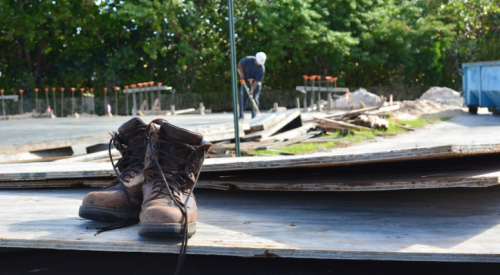In my column “What Labor Shortage?” I suggested that in this zero-sum game of finding subcontractors in a challenging market, there is, in fact, no trade shortage for the rare builder willing to do the right things.
Some of you no doubt find that notion absurd, while others who understand the truth in it may find it troubling. Those few builders that have attained “unicorn status”—attracting and keeping not only the best trade contractors but their best crews—may wish I didn’t publicly reveal their secrets. Yet there’s nothing new here from what I learned through my best home building mentors more than 30 years ago.
Pondering the inability of most in the industry to adopt such best practices, a quote from the venerable late Dr. W. Edwards Deming comes to mind: “You cannot copy, you must understand why.” Combine that with another Deming gem, “There is no substitute for knowledge,” and you begin to understand the problem.
RELATED
- Can We Make Home Building a Little Less ‘Interesting?’
- Lean Construction’s Greatest Hits, Vol. 1
- (Still) Waiting for the Home Building Technology Revolution
- Business Success: Easy as 1, 2, 3?
The 12 Absolutes for Solving Your Trade Shortage
I ended my previous column with a simple list of 12 absolutes; actions the very best builders—those that have solved their trade shortage—practice daily. These elements aren’t just part of their operating practices, they’re essential to their culture. Let’s spend a bit more time on each.
1. Pay trades fairly, quickly, and on time.
Not long ago I was called by a builder who felt his rapidly growing company was weak on systems and processes, especially at higher levels of production. We went to work with his committed, hard-working team and I can report tremendous progress is being made. Many of those process deficiencies in areas such as scheduling, communication, and lack of POs were indeed hindering supplier/trade relationships, but there was one saving grace: Any invoice received by Monday was paid that same week on Friday, without fail.
Most builders believe they do well if they pay twice monthly—and they are. Yet some still are stuck paying at 30 days, 60 days, or even longer. That’s uncompetitive. Trades will put up with a lot, though, if they know they’ll get paid immediately, and that was the case with this builder. The fact is, you need to pay fairly, quickly, and on time today just to be in the game.
2. Treat trades with dignity and respect.
This element has improved over the past 30 years and I give the Millennials and Gen-Xers credit for that. Most of the grizzled old guys who managed through screaming and intimidation have aged themselves out of the workforce. There’s no end of critics of the younger workforce, but I find them generally to be a kinder, gentler, more thoughtful group of managers. They’d rather negotiate their way to a solution than manage by brute force. Yes, exceptions still abound, and even younger supervisors fall victim to the true source of tyrannical behavior: fear and insecurity. Never forget that every worker has the same issues, problems, concerns, and needs as you. Even on the worst days, when everything goes wrong, there is never an excuse for robbing someone of their dignity.
3. Provide a clean, safe jobsite.
Is there anything more important for an employer to do than ensure a safe site? We learned a lot about that during COVID-19. And a jobsite is never completely safe until it’s clean. If OSHA is active in your area, all builders are forced to pay attention to site conditions, which helps even the playing field. But even without OSHA enforcement, maintaining safe sites sends a message to your trades that you care.
Some days you may have to remind them that they pay workers’ compensation premiums, too, and participation in safety education and enforcement is in their own best interests. If sites are clean when each trade arrives, it’s much harder for the next one to leave it messy, and if they do, you can identify the culprits and “reinforce” your standards. Most trades quickly figure out that working on a clean, safe site is to their advantage. Those that don’t shouldn’t be working for you.
The two largest areas of loss over the past decade are cycle time and variance (items 9 and 10, below). Inadequate training is a major source of the problem.
4. Have fully trained, competent builder field staff.
Training, except for sales teams, has fallen off dramatically since the big housing crash we left behind more than a decade ago. Before that brutal era, TrueNorth alone trained 10,000 people a year in its classes for home builders, and there were many other providers. Since then, demand for training is down more than 90%. The result is tremendous variation in how homes are built, scheduled, and managed. The two largest areas of loss over the past decade are cycle time and variance (items 9 and 10, below). Inadequate training is a major source of the problem. Why have builders significantly reduced training in the face of these critical needs? Coming out of the crash, those left were already well-trained, thus new hires were pulled from a large pool of experienced workers. The belief was, why train? As a result, everyone did their own thing, using different methods. We hear this complaint constantly from suppliers and trades. They want consistency and predictability, and both are lacking. Meanwhile, that pool has run dry now, and the need for training has never been more apparent.
5. Provide quick access to builder personnel.
In this day of cell phones, text messaging, email, and software purporting to eliminate much of the need for daily communication between builders, suppliers, and trades, it’s ironic that we hear these laments from trades as often as ever. Much of the cause lies in the two key issues mentioned in No. 4, above—schedule and variation. Today schedules average 50% to 100% longer than 12 to 15 years ago when the new technologies were in their infancy. Similarly, variance levels have doubled. Those two factors combined will not merely double the communication burden, they will more likely quadruple it. Add to this the shortage of trades and materials allocations and we compound the problem. This is, of course, not just a field issue. We hear just as much from the trades about communicating with purchasing, accounting, and other internal departments. Fixing it requires daily vigilance by your staff to keep every communication channel open and current, both externally and internally.
6. Ensure bid packages are accurate and complete.
Will I work (or even live) long enough to regularly find builders without a critical need for improvement in their bid packages? To get the bid package right, you must do so many other things well, including nailing down the exact final grade, final plans and elevations, definitive scopes of work for each trade, complete contract requirements, and final specifications for the standard house as well as every option and selection. That’s for starters, but without those, your purchasing department has no chance of getting the bid package right. Without a top-of-game bid package, how can you expect a trade to give you their best possible prices? It just won’t happen. The final key lies with management. The required decisions always get made, eventually. Let’s resolve to get decisions made up front, when your people need them to do their jobs.
7. Ensure start packages are accurate and complete.
If you want to know the status of your bid and start packages, demand a brutally honest answer to this question: “Does our bid package match our build (start) package?” Now, go pick five of your best, most knowledgeable and experienced trades and ask them. Any mismatch from their perspective, no matter how small, costs both parties money. The differences are often substantial. Get in the habit of asking this question for every home. The next step, when you find a mismatch, is to use the “5 whys” technique, asking “why?” five times, or until you get a clear answer. From my experience, about half of the problem stems from late changes to product or decisions that could have been made earlier—all the way back to the bid package—but weren’t. Ask any purchasing manager and they’ll tell you that trying to create a fully complete start package from an inadequate bid package is nearly impossible. So create some rules for this on your critical path and stick to them.
From my experience, about half of the problem stems from late changes to product or decisions that could have been made earlier—all the way back to the bid package—but weren’t.
8. Provide final plans with construction drawings.
This should be a provision of step 6, and if it isn’t a given in step 7, something is truly wrong. It’s so important though, that I chose to highlight plans as a separate item. Final lot-specific plans with all details on full construction drawings is one of the best ways to prevent problems. You will never ever save a dime shortcutting this process, but I can guarantee you’ll increase your costs if you measure and account for errors, mistakes, rework, and lost schedule days. Sit down with your trades and ask specifically what they want on their plans and what they don’t need. Do that, and have those needs built into the plans at the bid package stage every time.
9. Have a fully reliable construction schedule.
I’ve written many columns on schedule and cycle time because this is the heartbeat of the operation. Having worked with more than 200 builders in five countries, I can say, as an absolute, as goes the schedule, so goes the builder. No exceptions. You’ve seen firsthand how the quality and accuracy of your schedule affects your own people, not to mention your capital requirements. Now start paying attention and start listening to how the schedule affects your trades. Ask how many have to “scout” your homes to be sure they are ready for material delivery or a work crew. You’ll find it’s a large majority. That’s unacceptable, and each case is an opportunity for improvement. If everything else is even close to being equal, trades will pick the builder with the best schedule every time, and likewise provide them their best crews.
10. Eliminate variance purchase orders.
I initially wrote “minimal” as the goal for the level of variance, but that’s not strong enough. The goal should be zero VPOs. OK, you may never reach that goal because we all know “stuff happens.” But for virtually everyone, variance costs are higher than your calculations because those contain only labor and materials. Greater than those costs, however—usually at a multiple—is the impact on process, which means excess schedule days, wasted trips to sites, and increased overhead. No one tracks those factors, and, as I said above, variance rates are higher than ever across the industry. To bring variance down, commit to a total focus on items 6 through 9 on this list, and start measuring the true, total cost of variance.
11. Make back charges “rare to none.”
First, understand that any back charge is a failure for all. A true total cost analysis shows no one makes money on a back charge. Everyone loses. Get all of the other elements right and back charges will be minimal. Then ask yourself if it makes sense to back charge at all. A couple of the very best builders in America never issue a back charge; their system won’t even do one. But they do communicate aggressively to ensure every mistake, error, and omission is a learning experience. A high level of back charges also indicates you have system and process issues, possibly a poor trade base, or some combination. So dive deep, track and analyze each one, find the root cause, and eliminate it.
12. Get input into plans and specifications early and often.
Here’s another element that’s so simple, so obvious, yet it’s seldom seen. You build a product that today averages a median sales price of about $350,000 nationwide. You have somewhere between 30 and 45 significant contractors that do the actual building. Exactly how many of them had specific, detailed input into your plans before you even staked the lots? How many walked the homes with you the very first time you built them, giving their input? How many periodically review existing plans, looking for improvements? I’ve eliminated all but a precious few exceptional builders at this point, and I simply cannot understand why. The payoff is huge, yet seldom realized. Not only will getting trade feedback throughout the process save you significant dollars, it tells trades you value their expertise—something they rarely get from the building community. That makes a significant difference on their builder-of-choice rating scale.
A Vision of Operational Excellence
Those 12 points are a lot to ponder, but let me review a case history that has appeared a few times before over my nearly 24 years writing this column. Gary Grant, retired VP of construction and one of my best mentors, requested I meet his trade council without him and ask them what he could do to further support them. Gary had virtually no trade turnover, quality was top of game, and the prices he received were “better than competitive.” Everyone in town wanted to work for Gary. He’d nailed it, fulfilling each of the 12 absolutes listed above. How good was Gary’s operation?
Schedules were published with remarkable accuracy 60 days in advance, and not one of the 10 council members could recall a single wasted trip to a building site during the previous year. There was no “scouting” a jobsite to confirm it was ready. The president of Gary’s trade council, a plumber, put it this way, “We work for 15 to 20 builders each year and no one comes close to Gary. His plans, his start packages, his people, his schedule are all so good that I actually charge him the least of any builder we work with, and we make the most profit working for Gary.” The trade council’s feedback about what Gary could do to improve? “Nothing!” They all insisted, “Just tell him to keep doing what he’s doing.”
That’s a vision of operational excellence for everyone. Imagine if you could become only half as good as Gary. At your next local Home Builders Association or Building Industry Association event, while your competitors lament how the trade shortage is making them crazy, you can just sit back, smile, and say, “Trade shortage? What trade shortage?”













